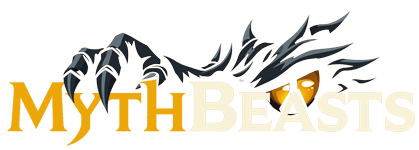Rahab: The Primordial Sea Monster of Chaos
Rahab is a colossal sea monster of Biblical origin, often depicted as a symbol of chaos and the untamed sea. In Hebrew scripture, Rahab represents a monstrous being subdued by God during the creation of the world, embodying the divine victory over chaos.
Though less known than Leviathan, Rahab’s presence in mythological texts speaks to ancient fears of the sea’s destructive power. Over time, Rahab evolved into a metaphor for the forces of pride and rebellion against divine order. His myth has influenced Jewish and Christian lore, and even appears in apocalyptic literature, symbolizing the primordial struggle between chaos and order.
History/Origin
Rahab’s origin lies within the Hebrew Bible, where he is often mentioned in poetic and prophetic books such as Job and Psalms. Scholars suggest that Rahab’s name may derive from a root word meaning “to be proud” or “violent,” both traits fitting his character as a sea monster symbolizing prideful chaos. In Job 9:13 (NIV), Rahab is introduced as an adversary subdued by God:
“God does not restrain his anger; even the cohorts of Rahab cowered at his feet.”
This depiction of Rahab as a creature humbled by divine power reflects ancient Near Eastern mythology, which often portrayed gods battling sea monsters to establish cosmic order. In the Book of Isaiah, Rahab is again referenced, representing Egypt and symbolizing chaos and opposition to God’s people:
“Awake, awake, put on strength, O arm of the Lord; awake as in the days of old, the generations of long ago. Was it not you who cut Rahab to pieces, who pierced the dragon?” (Isaiah 51:9, ESV).
These passages illustrate Rahab’s dual role as both a literal monster and a metaphor for nations that oppose God’s will. In Psalm 89:9-10, Rahab is explicitly linked to the sea:
“You rule over the surging sea; when its waves mount up, you still them. You crushed Rahab like one of the slain; with your strong arm you scattered your enemies.”
This imagery aligns Rahab with other ancient sea monsters, such as the Babylonian Tiamat, representing the chaotic forces subdued by a creator deity.
Name Meaning
The name “Rahab” is rooted in Hebrew and means “proud” or “boisterous,” reflecting the creature’s association with the tumultuous and uncontrollable aspects of the sea. Some interpretations also link Rahab to the idea of arrogance or insolence, characteristics often used to describe mythological beings that challenge divine authority. Rahab’s name serves as a reminder of the sea’s unpredictable power, which ancient cultures sought to comprehend through stories of divine conquest.
Background Story
Rahab’s most significant narrative centers around his defeat by God, which is part of the creation myth described in Jewish traditions. According to these stories, the world was initially a formless void dominated by chaotic waters. Rahab, as the embodiment of these primordial waters, posed a threat to the emerging order. God’s triumph over Rahab, often depicted as a fierce struggle, symbolizes the subjugation of chaos and the establishment of a structured world.
Though Rahab is subdued, he is not entirely destroyed. Some texts suggest that he remains in the depths, held back by divine power, ready to be released in the end times. This adds an apocalyptic dimension to Rahab’s myth, hinting that he may resurface as part of a final, cosmic battle. In this way, Rahab is often paralleled with Leviathan, another sea monster, and both are sometimes seen as allies in opposition to God.
Similar Beings
Rahab shares many characteristics with other chaos monsters from different mythologies. For instance, Tiamat from Babylonian mythology is also a sea monster subdued by a god to bring order to the world. The Canaanite god Yam, who represents the sea and chaos, has similar traits, as does the Greek monster Typhon, a massive, stormy creature opposed to Zeus. These beings reflect ancient civilizations’ attempts to personify and control the natural world’s destructive forces through mythology.
Rhab, Liviathan and Tanin
Rahab, Leviathan, and Tanin are all formidable sea creatures in ancient Hebrew and Near Eastern mythologies, each symbolizing chaos and opposition to divine order. While they share similarities, particularly as representations of untamed nature, there are distinctions in their characteristics and roles:
Rahab
Symbolism: Rahab primarily symbolizes pride and rebellion, and in some texts, he represents chaos at a cosmic level. He is often associated with Egypt, metaphorically representing the forces that oppose God and are ultimately subdued.
Role: Rahab is depicted as an adversary defeated by God during creation. He embodies the primordial sea and chaos subdued to establish order. Rahab doesn’t have as many details surrounding his appearance or attributes as Leviathan.
Association with Creation: Rahab is closely tied to the creation myth, where God asserts dominance over chaotic forces. He is sometimes interpreted as an embodiment of the roaring, destructive seas that needed to be tamed to create a habitable world.
Leviathan
Symbolism: Leviathan often represents evil and chaos, but he is also a symbol of a creature that is seemingly indestructible and awe-inspiring. He has been associated with the end times and sometimes represents evil itself or Satan in Christian interpretations.
Role: Leviathan is described in more physical detail than Rahab, typically portrayed as a massive serpent or sea dragon with scales like armor. In the Book of Job, he is depicted as a powerful, almost godlike creature that only God can control.

In Apocalyptic Literature: Leviathan plays a significant role in Jewish eschatology as part of the events of the end times. He is sometimes described as one of the great beasts to be slain at the final judgment, symbolizing the ultimate defeat of chaos and evil.
Tanin
Symbolism: The word Tanin is a more general term, which can mean “serpent,” “dragon,” or “sea monster.” Tanin symbolizes the chaos and danger of untamed nature, but its role is not as singular or specific as Rahab or Leviathan.
Role: Tanin is often mentioned alongside creatures like Rahab and Leviathan, and sometimes they are collectively referred to as the chaos monsters. The Taninim (plural of Tanin) are referenced in Genesis as sea monsters created by God, signifying that they are part of God’s creation rather than just symbols of opposition.
Less Defined Mythos: Tanin does not have a distinct mythological narrative like Leviathan or Rahab. The term is more of a descriptor and can refer to various monstrous forms, from dragons to serpents, found across Hebrew and Canaanite lore.
Key Differences
- Individual Identity: Rahab and Leviathan are typically considered individual creatures with distinct stories and roles, while Tanin serves as a more general term for monstrous beings.
- Narrative Role: Rahab’s narrative is primarily one of pride and rebellion, subdued early in the creation story. Leviathan, however, is often depicted as an ongoing challenge, a force that awaits judgment at the end of times. Tanin does not usually have a unique, personalized narrative and often appears in general references to serpents or sea monsters.
- Cultural Impact: Leviathan has perhaps the most extensive cultural impact, influencing Jewish, Christian, and even broader Western iconography. Rahab is more specialized, typically appearing in Hebrew texts as a personification of Egypt or chaos. Tanin’s impact is diffuse due to its broader use and less specific associations.
In sum, while all three creatures symbolize chaotic forces and are connected with water or the sea, Rahab and Leviathan have more defined roles and narratives within Biblical and apocalyptic literature, whereas Tanin serves as a more generalized term for monstrous or serpentine beings.
Cultural Impact
In Jewish folklore, Rahab became a symbol for nations that opposed Israel, with particular references to Egypt as Rahab. This metaphorical usage reflects Rahab’s role in representing chaos and opposition, not just on a cosmic level, but also in political and social contexts. Rahab’s defeat by God is seen as a demonstration of divine justice, establishing God’s sovereignty over the forces of disorder.

Rahab’s influence extended into apocalyptic literature, where he often symbolizes the forces that will resurface during the end times. In these stories, Rahab represents the ultimate expression of chaos and rebellion, a fitting foe for a final cosmic confrontation.
Rahab also appears in Talmudic and Midrashic texts, where he is sometimes depicted as a dragon-like creature, blending characteristics of various mythological beings. These writings explore themes of pride, rebellion, and the dangers of opposing divine will, with Rahab serving as a cautionary figure.
Religion/Ritual
While Rahab does not play a central role in religious rituals, his name and story are invoked in various Jewish prayers and texts as a reminder of God’s power over chaos. For instance, during Passover, the concept of God’s victory over chaotic forces like Rahab may be reflected in the narrative of the Exodus, where God overcomes the “chaos” represented by Egypt. This connection to chaos and divine control highlights Rahab’s role as an adversary overcome by faith and divine intervention.
Scientific or Rational Explanations
Some scholars propose that Rahab may have originated from ancient perceptions of natural disasters, particularly those involving the sea. Ancient peoples often viewed the sea as a symbol of chaos, representing both physical and existential threats. Rahab’s portrayal as a monstrous, chaotic force may reflect early attempts to personify these dangers, offering a narrative framework to explain and perhaps alleviate the fear of natural calamities like storms, floods, or tsunamis.
In terms of historical context, Rahab’s association with Egypt may also reflect political tensions between Israel and its powerful neighbors. By depicting these nations as chaotic monsters, the texts convey a moral about the futility of opposing divine will.
In Modern Culture
Though less prominent than Leviathan, Rahab has made appearances in various modern cultural works. In literature, Rahab has been referenced in fantasy novels that explore themes of chaos and creation. In C.S. Lewis’s The Magician’s Nephew, part of The Chronicles of Narnia, Lewis references Rahab indirectly when describing Aslan’s victory over the primeval waters, which echoes Rahab’s defeat.
Rahab also appears in contemporary art and music, often as a symbol of untamed nature. Some artists depict Rahab as a serpent or dragon, visually linking him to other mythological chaos beasts. In music, Rahab’s story is occasionally invoked to illustrate themes of struggle and divine conquest, especially in genres like metal, which often explore apocalyptic imagery.
In video games, Rahab is featured as a character or boss in titles that explore mythological themes. For example, in Legacy of Kain, Rahab is one of the vampire lords, a serpentine creature whose name and attributes are inspired by the mythological sea monster. This modern portrayal of Rahab as a formidable foe to be conquered reflects the enduring appeal of chaos monsters as symbols of both fear and fascination.










